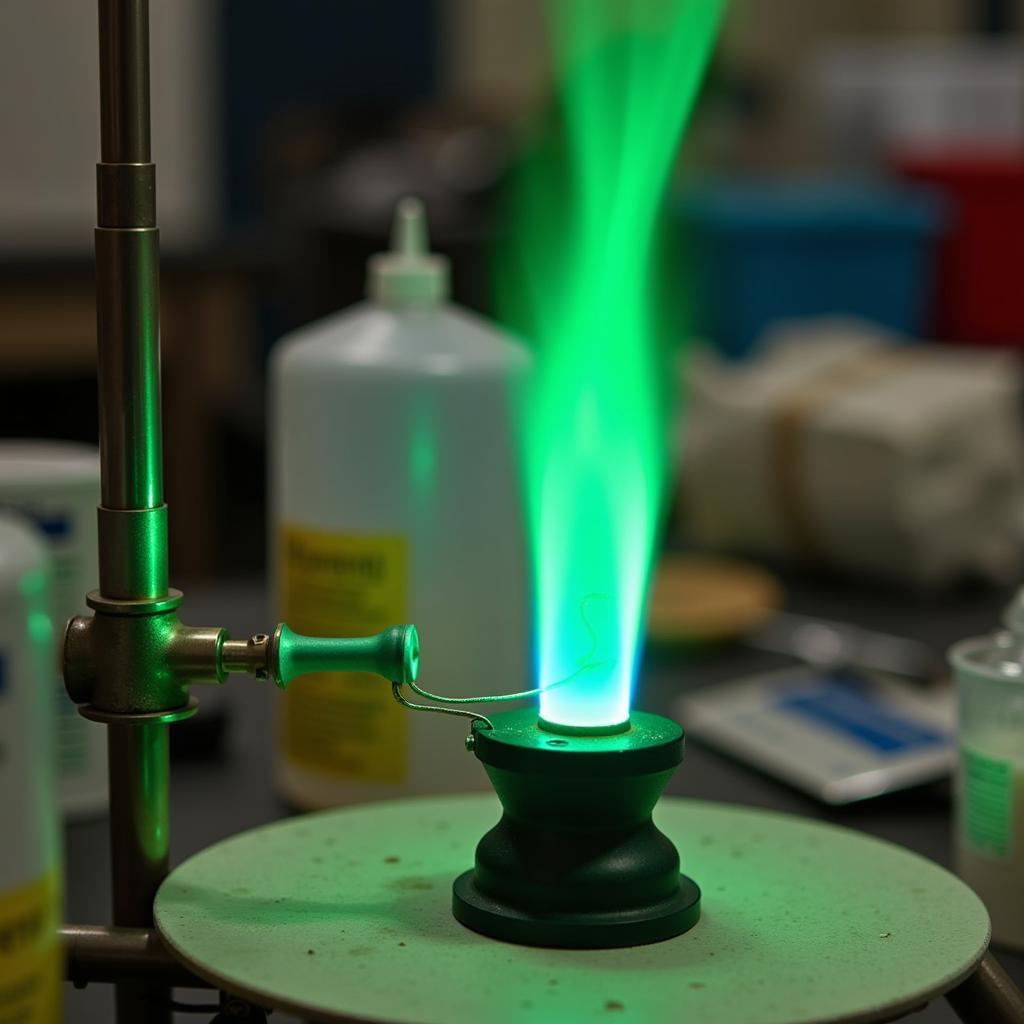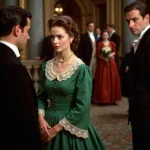Barium chloride, a common laboratory chemical, produces a vibrant green flame when burned. This distinct color is a key identifier for barium and is often used in qualitative analysis to confirm its presence. But why does barium chloride burn green, and what are the underlying scientific principles behind this phenomenon?
Unveiling the Science Behind the Green Flame
The mesmerizing green hue arises from the electronic transitions within the barium atoms. When barium chloride is heated in a flame, the energy absorbed excites the electrons to higher energy levels. As these electrons return to their original, lower energy states, they emit energy in the form of light. The specific wavelength of this emitted light falls within the green spectrum, hence the characteristic green color. This process is known as atomic emission. It’s similar to how to make different color flames, where different metal salts produce different flame colors.
 Barium Chloride Flame Test Showing Green Color
Barium Chloride Flame Test Showing Green Color
Factors Influencing the Intensity of the Green Color
The intensity of the green color can be affected by various factors, including the concentration of barium chloride, the temperature of the flame, and the presence of other elements. A higher concentration of barium chloride typically results in a more intense green flame. Similarly, a hotter flame provides more energy for excitation, leading to a brighter emission. However, the presence of other elements can sometimes mask or alter the green color.
This principle is explored in greater detail when understanding why do fireworks have different colors, where a complex interplay of various chemicals creates the spectacular displays we see.
Why Isn’t the Flame White?
If barium chloride emits light in the green spectrum, why don’t we see other colors in the flame? While barium predominantly emits green light, it also emits small amounts of light at other wavelengths. However, the green emission is so dominant that it overwhelms these other colors, resulting in the perceived green flame. This is analogous to mixing a small amount of red paint with a large amount of green – the resulting mixture will still appear predominantly green.
 Barium Chloride Spectrum Analysis showing Green Wavelength Dominance
Barium Chloride Spectrum Analysis showing Green Wavelength Dominance
Applications of Barium Chloride’s Green Flame
The distinctive green flame of barium chloride has several practical applications. It’s used in fireworks to create brilliant green displays, adding another dimension to the colorful spectacle. In analytical chemistry, the flame test serves as a simple yet effective method for identifying barium in unknown samples. Learning how to make fire colorful opens up a world of possibilities, from pyrotechnics to scientific analysis.
Safety Precautions When Working with Barium Chloride
While barium chloride is a fascinating chemical, it’s essential to handle it with care. It is a toxic substance, and appropriate safety measures should always be taken when working with it. This includes wearing gloves, eye protection, and working in a well-ventilated area.
“Barium chloride, while useful, requires careful handling due to its toxicity. Always prioritize safety protocols when conducting experiments,” advises Dr. Amelia Chen, a leading chemist at the National Chemical Laboratory.
Conclusion
The vibrant green flame produced by burning barium chloride is a captivating phenomenon explained by the principles of atomic emission. Understanding this process not only enhances our appreciation for the beauty of chemistry but also provides valuable insights into its practical applications, from fireworks displays to analytical testing. Remember to always handle barium chloride with care and follow proper safety guidelines.
FAQs
- What causes the green color in the barium chloride flame? The green color is due to the specific wavelength of light emitted by excited barium atoms as they return to their ground state.
- Can other elements produce green flames? While barium is known for its intense green flame, other elements can contribute to a green hue, although typically less vibrant.
- Is barium chloride safe to handle? No, barium chloride is toxic and should be handled with appropriate safety precautions.
- How is the barium chloride flame test performed? The test involves introducing a small amount of barium chloride into a flame, typically using a platinum or nichrome wire loop.
- What are the practical applications of barium chloride? Barium chloride is used in fireworks, analytical chemistry, and other industrial applications.
- What happens when barium chloride is mixed with other chemicals in a flame? The presence of other chemicals can alter the color of the flame, sometimes masking or enhancing the green color.
- Why does the intensity of the green flame vary? Factors like concentration, flame temperature, and the presence of other elements influence the intensity of the green color.
Need support? Contact us at Phone: 0373298888, Email: [email protected], or visit us at 86 Cau Giay, Hanoi. Our customer service team is available 24/7.

